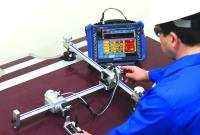 Add My Company
Add My Company
Sign In

In the following article, Neil Harrap, NDT Market Manager at Ashtead Technology, explains how the latest testing technology can be employed to improve the ease and efficiency with which composite materials can be evaluated.
Background
Composite materials are employed in a wide variety of industries in which specific material characteristics are required. For example, in comparison with traditional materials, composites can be designed to be: stronger, stiffer, lighter, more resilient, thermally stable, corrosion resistant and easier or less costly to manufacture. As a result, composites are commonly employed in sectors such as aerospace, automotive, construction, consumer goods, energy (e.g. wind turbines), marine, medical and military.
Most composites consist of a bulk material, the matrix, and a reinforcement which is usually in fibre form. Broadly speaking, composites can be divided into three main groups:
1. Polymer Matrix Composites (also known as fibre reinforced polymers) which use a polymer-based resin as the matrix, and a variety of fibres such as glass, carbon, aramid and natural fibres as the reinforcement.
2. Metal Matrix Composites which use a metal such as aluminium as the matrix, and reinforce it with fibres such as silicon carbide.
3. Ceramic Matrix Composites which use a ceramic as the matrix and reinforce it with short fibres such as those made from silicon carbide and boron nitride. These composites are suitable for very high temperature applications.
In contrast with most other manufactured materials, composites are non-homogenous (not uniform in structure or composition) and anisotropic (have properties that differ according to the direction of measurement). In addition, composites vary enormously in terms of shape and thickness. Testing therefore presents a number of challenges and a wide variety of testing procedures exist: compressive strength, content analysis, flexural properties, moisture absorption, shear response, tensile testing etc. However, all of these tests are destructive so Non-Destructive Testing (NDT) is required to assess materials that are either in the manufacture stage or in service.
Flaws that are not visible to the eye can have serious, if not catastrophic, effects on the ability of a composite to perform to its specification. Examples of composite flaws include delamination, disbond, translaminar cracking, voids, fibre breakage etc. These flaws can be created by incorrect manufacture or curing conditions, or they might occur as a result of operational stress, impacts or environmental factors such as temperature or humidity.
NDT Inspection Technology
The Omniscan MX2 Phased Array ultrasonic flaw detector has been added to the Ashtead Technology rental fleet of advanced NDT instruments. Representing a massive leap forward in technology, the MX2 greatly improves the speed and accuracy with which inspections can be undertaken.
Inspection work has been simplified by an intuitive step-by-step wizard that takes the operator through the process; ensuring that inspections are effective and fast. The MX2 also features the industry-standard phased array user interface with a bigger (26.4 cm) and brighter screen which has unique intuitive touch-screen capabilities, and faster data transfer. Generated images are based on 3 planes so the quality of reports is improved and with easier recording and archiving of data, higher levels of accountability are possible for composite inspection. This capability is also advantageous in situations where very low, acceptable, levels of disbond are identified and subsequently regularly monitored.
Composite testing options
The Omniscan MX2 can be combined with other components to form a complete inspection system. For example, phased array probes, scanners, analysis software, and other accessories can be integrated into a rapidly deployable, application-specific solution to meet a particular inspection requirement.
Bond testing can be performed by the MX with ECA module, and BondMaster® probes. The combination of these technologies increases the probability of detection of the pitch-catch bond testing method, because live amplitude or phase C-scan images with up to 8 frequencies are created.
Any two-axis encoding scanner can be used with this system. For example, the GLIDER™ scanner is ideal for flat or slightly curved surfaces, and the WING™ scanner is specially designed for scanning curved parts (e.g., aircraft fuselages) and can even be used upside-down due to its vacuum-cup system.
Many components manufactured as composites, such as skins, stringers, and spars, consist of relatively flat sections, for which a complete inspection solution is available. For example, the Carbon-Fibre-Reinforced Polymer (CFRP) flat panel inspection solution is based on the MX2, a GLIDER™ scanner, in addition to probes and specific wedges developed for CFRP flat panel inspection. This solution offers advanced features, such as two-axis encoded C-scans with amplitude and time-of-flight (TOF) information, gate synchronisation, and data recording.
Summary
Composite inspection by NDT represents a vitally important component of the manufacturing process; in-service checks to ensure that materials remain fit for purpose, and procedures to evaluate the success of repair work. Appropriate training is necessary for those responsible for these activities, but for those who may not have experience with the latest advanced inspection techniques, Ashtead Technology has invested in an ‘NDT Centre of Excellence’ to provide help and advice on which equipment to use and how to configure it for the best results.
Too often, engineers are wary of new technology, fearing that its use may incur a greater need for training, in addition to a significant period of familiarisation. However, whilst the MX2 has been developed to offer new levels of inspection productivity, the designers have retained a focus on simplicity; operation is highly intuitive and new users can become fully operational very quickly.
For more information on Latest technology for non-destructive testing of composites talk to Ashtead Technology Ltd
Enquire Now
More News
List your company on FindTheNeedle.

